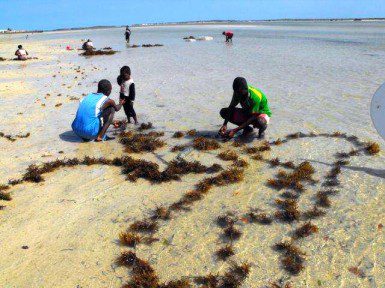By Harry Harty, Blue Ventures volunteer, Madagascar
As a non-diving volunteer my 12 weeks here at Andavadoaka are being spent undertaking various terrestrial based activities. Last week BV’s Aquaculture Project Coordinator, Antoine approached me about joining him on one of his 4 day trips to Tampolove, a village just south of Andavadoaka, to do some work with his sea cucumber and seaweed aquaculture projects. Of course I jumped at the chance and we set off on the morning of the 11th after a brief breakfast at 8.30am. A great bonus was that we would be taking a motorised pirogue which meant we wouldn’t have to be relying on the wind in order to get down to Tampolove. We set off and as soon as we were out of the bay our pirogue captain dropped in a line and hook into the ocean in the hope of catching dinner! And that he did do, a lovely big Mackerel!
Antoine, along with colleagues Zizenne, Josevah and I arrived at Tampolove a few hours later and settled into our hotel whilst Antoine prepared for his meeting with the sea cucumber farmers. We used our spare time to apprehend a local guide and do some bird watching. Antoine wanted to see the rare long tailed ground runner and so we set off in search for one. After a nice walk through the spiny forest we had no such luck but along the way spotted some fantastic birds in the Running Coua and the Lovebird (a tiny parrot!).
As sea cucumbers only come out of the sand at night, at 9.30pm Antoine called me and we got the equipment ready for the night ahead; lanterns for the farmers, weighing scales and some warm clothes and booties to fend us from the crabs and urchins! We walked out into the bay around 10.45pm and each farmer made off for their respective pens. The pens are divided into the various generations of sea cucumbers with a small covered pen containing the newest additions. We would make our way around to each farmers pen once they had counted 2 out of the 4 generations they had (doing four generations at a time is too time consuming so each time the tides suit two generations are done at a time) and the numbers from each of the two generations were noted. Each time a purchase takes place 300 new babies are bought per farmer and so the numbers each time are noted to get an indication of survival rates. Of the sea cucumbers counted, very rarely less than 260, a random selection of 50 from each of the two generations was taken and weighed individually to get an average weight. We spent approximately 2-3 hours monitoring that night.
The next morning we had some breakfast and made for the village of Lamboara around 8am, which was only a short pirogue journey across the bay. Once we had arrived, in true Malagasy fashion everyone was already up getting on with their jobs. There were men and women alike scattered along the beach of this lovely little island among the mangroves with 10m lengths of rope with about 20 small loops along each one into which they were tying seedlings, readying them for placement in the shallow tide. Once a number of strings were ready they carried them out into the tide and placed them in the water with weights at either ends to keep them in place and floats to keep the sea weed off the bottom. The sea weed once harvested is dried and used as gelatine in the production of food stuffs and as a general replacement to the gelatine extracted from animals. One of the highlights of this day was seeing a group of kids no older than 8 or 9 sat together on the beach imitating their parents with their own tiny strings of sea weed to put in the sea, a true testament to the hard work being put in and the positive effect it is having.
After a few hours in Lamboara we set off back to Tampolove to get some food and rest up for the next night of sea cucumber monitoring. This night was much the same as before with the exception of some fish spotting along the way. There were all sorts pottering about the shallows from sea hares to puffer fish! Some of the farmers also ventures out further a field in order to spear hunt for dinner the next day, with evident success! Although the cultivation of sea cucumber provides them with some income, they are all fishermen too. The income generated from this aquaculture takes big pressure off the locals to constantly fish, thus further depleting fish stocks.
The next day was a relatively relaxing day in Tampolove and with much delight all the sea cucumber monitoring was done! This day would be spent making our way to the village of Vatoavo in order for Antoine and Josevah to meet with the village’s president, who had a great desire to start an aquaculture project. After a long and passionate talk with the president and a brief assessment of the surrounding waters, we set off back for Tampolove.
The rest of the day was spent in-putting some data and then we went on another bird watching trip. Our guide had told us he knew the whereabouts of a nest belonging to the rare Madagascar Harrier-Hawk. We strode into the stunning mangroves around Tampolove and found the place the nest was situated but no hawks in sight. After a while of watching the nest, we set off to take in the rest of the sites around the mangroves and then retired back to the hotel to rest before our 2 hour zebu cart ride back to Andavadoaka the next day.


